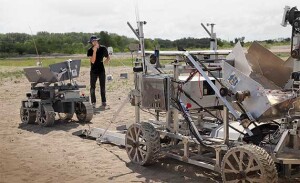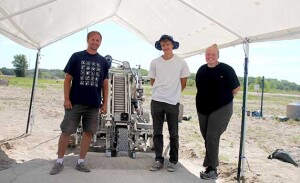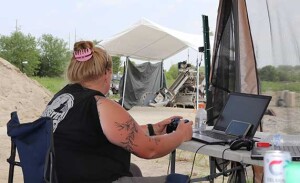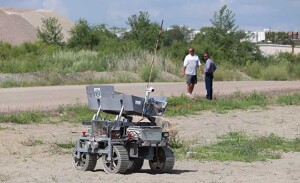A quest for success in a NASA lunar challenge has tested the physical and mental strength of a group of SDSU engineering faculty and students while at the same time exciting them about the future.
Mechanical engineering faculty member Todd Letcher ’05, electrical engineering colleague Jason Sternhagen ’98/M.S. ’01 and three of their students were on a mission to ensure that an autonomously operating excavator continued to grind away at soft concrete and then load it into an autonomously operated dump truck, which took it to a drop site one-third of a mile away to be weighed.
The project motivated them to work 15- to 17-hour days outdoors this summer, even when temperatures were in the mid- to upper 90s. At night the coyotes howled in the near-total darkness. On one Saturday, they had to spring into emergency mode when a torrential downpour suddenly struck.
Their summer determination was the result of preliminary success in NASA’s Break the Ice Lunar Challenge, which aims to develop new technologies that could support a sustained human presence on the moon by the end of the decade. In December 2022, the SDSU team, Space Trajectory, was named one of 15 finalists in the international competition.
The Jerome J. Lohr College of Engineering’s success in Break the Ice was soon followed by success in two other NASA competitions.
Lunar transport team claims first
 Letcher also oversaw student entries in the Revolutionary Aerospace Systems Concepts – Academic Linkage (RASC-AL) competition, which involved designing and building a lunar transporter vehicle, and FLOATing DRAGON, which is NASA shorthand for Formulate, Lift, Observe, And Testing; Data Recovery And Guided On-board Node.
Letcher also oversaw student entries in the Revolutionary Aerospace Systems Concepts – Academic Linkage (RASC-AL) competition, which involved designing and building a lunar transporter vehicle, and FLOATing DRAGON, which is NASA shorthand for Formulate, Lift, Observe, And Testing; Data Recovery And Guided On-board Node.
SDSU was one of six finalists in the FLOATing DRAGON balloon challenge, which included engineering bluebloods like Princeton, Purdue and the University of Texas.
In the RASC-AL competition, SDSU was one of 15 finalists in four categories. Other finalists included Massachusetts Institute of Technology, Virginia Tech and Embry-Riddle Aeronautical University. Competing in the Lunar Surface Transporter Vehicle category, SDSU came in first, beating Maryland, Texas and Virginia Tech.
The Break the Ice team is competing against two other schools, firms from India and the Netherlands and U.S. space engineering firms, including Redwire Space.
Contests let State compete AGAINST elites
“The NASA contests have given us a chance to display our talent,” Letcher, an associate professor, said. “We’ve always been considered an ag school, even in the engineering college. Now that we’ve found success in these NASA contests, it has put us in a different category.”
SDSU students don’t normally cross paths with peers at Princeton or MIT. Letcher said one could ask of SDSU, “How do you compare against these other schools? How do you compare yourself to other companies doing aerospace?”
Like all 15 finalists, its excavator needed to work autonomously for 15 consecutive days, recording how much concrete the heavy-duty aluminum machine could grind. The pit of low-strength concrete represents the icy soil found on the moon. NASA’s theory is that the soil can be excavated and the ice melted so humans can use the water.
The teams’ results and detailed paperwork need to be submitted by Oct. 27 with NASA to announce Phase II winners and Phase III qualifiers in December.
Contests put students on new path
Allea Klauenberg already feels like she is a winner.
“It’s been my favorite part of college. Being able to design and build (battery-swapping) rovers is not an experience I could have gotten anywhere else. We’ve spent so long designing, to see it actually come through and work has been amazing,” said Klauenberg, who had “no idea” what she wanted to do in the field of engineering when she was a high school student in Ogden, Iowa.
But an email from Letcher in January 2021 began a process that has shaped the mechanical engineering student’s life.
That email invited her to participate in NASA’s Deep Space Food Challenge competition. “It sounded interesting, and I thought, ‘Why not?’” In January 2022, she had the chance to join the Space Trajectory team and was responsible for designing, fabricating and testing the battery-swapping rovers
and the charging station.
She earned her bachelor’s degree in May and had a full-time job opportunity awaiting her.
“I decided a week before graduation (to go to grad school), and this project definitely had a big influence on that decision. We realized we had a good chance to move on to Phase III. Starting a full-time job wouldn’t have allowed me to do that. Being able to continue this project with it serving as the thesis for my master’s degree was a big point.
“I would absolutely love continuing to work on NASA competitions. A position at NASA would be a dream come true.”
‘If you want to change the world’
Most of this last school year’s 16-student team has moved on to full-time jobs. That’s why the days were so long at the Break the Ice testing site. But Klauenberg isn’t the only student to have the course of her life altered through a NASA project.
Of the five mechanical engineering students who participated in the winning RASC-AL competition, four have decided to pursue graduate school with an aerospace focus.
“It really changed the trajectory of their lives,” said Letcher, who is looking to enter students in up to four NASA competitions this school year.
Sternhagen, the electrical engineering faculty member, said, “I like to tell students, if you want to change the world, engineering is where it happens.”
Dave Graves






